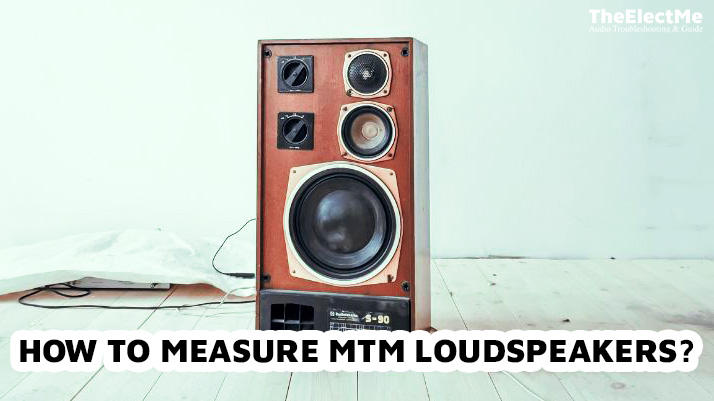MTM speakers, known for their Mid-Tweeter-Mid configuration, are designed to enhance audio performance. These speakers typically have a midrange driver between two tweeters, offering a unique sound experience. The precise alignment of these components is crucial for achieving optimal sound quality.

How to measure MTM loudspeakers? Proper measurements improve audio accuracy, making the listening experience more immersive and enjoyable. Understanding the configuration of MTM speakers is essential to measure them accurately.
By focusing on these aspects, you can effectively measure it. Let’s start with the tools and equipment required for the task.
Tools and Equipment Needed
To measure MTM loudspeakers, you will need the following tools and equipment:
Here are the necessary measuring devices required for this task:
- Multimeter- A device used to measure electrical current, voltage, and resistance.
- SPL Meter: A sound pressure level meter that measures the loudness of sound.
- Calibrated Microphone: A microphone calibrated to measure sound levels accurately.
- Tape Measure: To measure the distance between components.
- Angle Protractor: To measure the angles of the speaker components.
These measuring devices are essential for accurate and precise measurements. Let’s explore the setup requirement and the actual measurement process.
What Is The Setup Requirement?
Before measuring MTM loudspeakers, you must ensure they are set up correctly. Here are some setup requirements to consider:
- Positioning: Place the speakers on a stable surface, at least 6 feet apart.
- Angles: The tweeters should be angled towards the listening position, typically at a 30-degree angle.
- Height: The midrange driver should be placed at ear level for the best sound experience.
- Wiring: Ensure the speakers are correctly wired and connected to a power source.
Proper setup ensures accurate measurements, allowing for optimal audio performance. Now, let’s dive into the actual measurement process.
How To Measure MTM Loudspeakers?
Measuring MTM loudspeakers involves a speaker driver, multi-driver, and crossover frequency. Before starting measurement first look at the types of magnets used in a speaker. There are 4 different types of speaker magnets. Let’s start with measuring the speaker driver:
Speaker Driver Measurement
To measure the speaker driver, follow these steps:
Cone Diameter Measurement: When determining the cone diameter of a speaker driver, measure the distance across the widest point of the cone. It includes the width of the surround on one side is crucial. This measurement helps understand the effective cone area, significantly influencing sound performance.
Impedance Measurement: To measure the impedance of a speaker driver accurately, users can utilize a multimeter. Individuals can ensure proper compatibility with amplifiers by measuring the impedance. Place one multimeter lead on each driver’s terminal when testing the impedance. The resistance measured should closely match the speaker’s nominal impedance value.
Multi-Driver System Measurement
A multi-driver system includes multiple speakers, typically the midrange driver, and two tweeters. To measure this system accurately, follow these steps:
Scaling Measurements: When working with multi-driver systems, adjusting SPL readings for the combined output of multiple drivers critically. Scaling measurements allow users to assess the system’s overall sound pressure levels accurately.
Impedance Adjustment: In multi-driver setups, understanding impedance changes is essential. As multiple drivers interact within the system, impedance levels can vary. Users must grasp impedance changes to match amplifiers and avoid sound quality problems.

Room Response Analysis
After measuring individual components, assess the speaker’s overall performance by analyzing room response.
In-Room Response: To measure in-room response, utilize an SPL meter to assess the overall sound pressure levels. This measurement helps identify any audio distortion or inconsistencies caused by room acoustics. Users can then make necessary adjustments to improve sound performance.
Frequency Response: To measure frequency response, use a calibrated microphone. Place the microphone in the listening position and play a frequency sweep. The recorded response should closely match the manufacturer’s specifications.
After completing the measurement process, ensuring all components are correctly aligned and connected is crucial. You can also use a relay to power the speaker. Let’s explore the alignment process further.
How To Align MTM Loudspeakers?
To align MTM loudspeakers correctly, follow these steps:
First, ensure the speakers’ placement meets the setup requirements mentioned earlier. Then, follow these steps for proper alignment:
Tweeter Alignment
- Set up an angle protractor on top of the tweeters.
- Adjust the tweeters until they match the desired angle (usually 30 degrees).
- Double-check that both tweeters are at the same angle.
- Use a tape measure to ensure they are equidistant from the listening position.
Midrange Driver Alignment
- Place an angle protractor on top of the midrange driver.
- Adjust the midrange driver until it matches the desired angle (usually 0 degrees).
- Ensure that it is at the same level as the tweeters.
- Use a tape measure to ensure it is equidistant from the listening position.

Crossover Alignment
- Connect the crossover network to the speakers.
- Play a test tone through one tweeter at a time and adjust the crossover until both tweeters have an even output level.
- Repeat this process for the midrange driver, ensuring even output levels.
- Use a multimeter to measure the resistance of each driver and adjust the crossover accordingly to achieve a balanced impedance.
Following these steps, you can properly align your MTM loudspeakers. It also increases your speaker performance.
If you face any sound quality issues, contact a professional for assistance in aligning your speakers.
Conclusion – How To Measure MTM Loudspeakers?
A MTM loudspeaker setup requires proper positioning, angles, height, and wiring. To measure the speaker driver accurately, measure the cone diameter and impedance. Multi-driver systems require scaling and impedance adjustments for accurate measurements.
Room response analysis through in-room and frequency response measurements helps assess overall performance. Finally, proper alignment is crucial for optimal sound performance.
Regularly checking and adjusting speaker alignment is necessary to maintain high-quality sound output.



